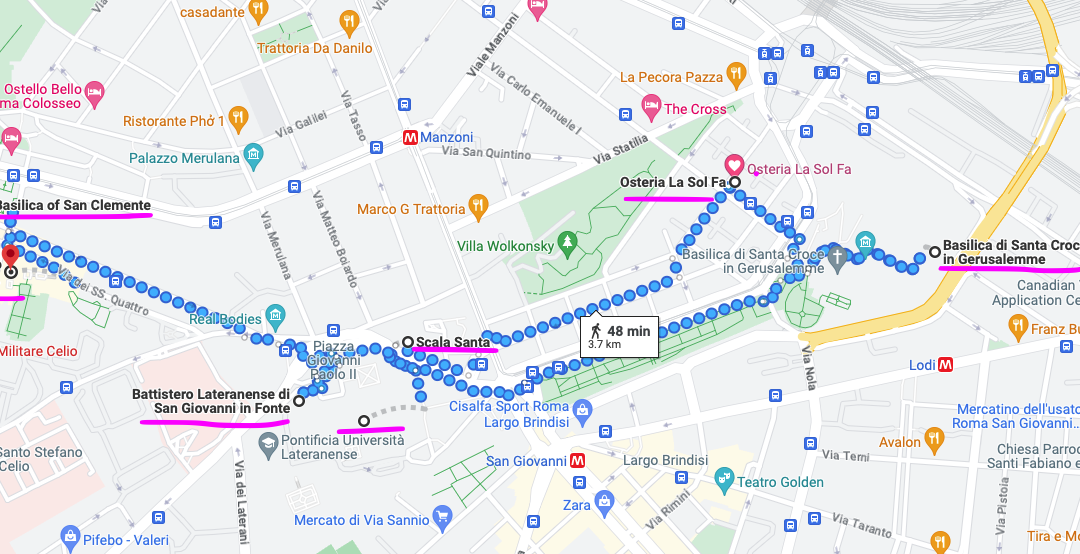My sister has this really awesome book of walking tours for Rome (I forget the name), so before I left for my first day, I took a pic of the first tour–Walking Tour 1 near San Giovanni in Laterano–and I decided to start there.

The churches on this tour were:
- Santa Croce in Gerusalemme
- San Giovanni in Laterano
- Scala Sancta
- Battistero Lateranense
- Santi Quattro Coronati
- San Clemente
Missing the Holy Cross
After spending quite some time in the Archbasilica of St John Lateran (see post about that here), I decided to make my way to the Basilica di Santa Croce in Gerusalemme, the Basilica of the Holy Cross in Jerusalem.
This Basilica is a short walk through a park from the Lateran, and it was a lovely day. Granted, I was already feeling very tired. This is a pic of St John Lateran at my back as I walked through the lovely park in between it and Santa Croce in Gerusalemme.

The walk through the park was lovely. I sat down for a minute to take it all in. I can still feel the Roman sun on my face.

Unfortunately, by the time I got to Santa Croce, it was just closing–for three hours! See the small group of nuns sitting together in front of the Basilica? I SO wanted to just go over and be all, “Hi! Can I hang out with you?!”
I love nuns.
But I didn’t.

I knew, at this time of day, I had a few hours to wait before things opened up again, so I searched my phone for good places to eat nearby, and I landed on a place named Osteria La Sol Fa, as in DoReMeFaSolLaTiDo.

Cacio E Pepe
While I had been trying to fast before coming on this trip, I was doing so much walking, I figured I should eat something, so I walked to Osteria La Sol Fa. I’m so glad I did.
I have always wanted to try cacio e pepe. It’s not something I see in my neighborhood, despite the fact that it is riddled with fourth and fifth generation Italians. Cacio e Pepe is basically pasta with parmesan cheese and pepper. When I saw it on the menu at Osteria La Sol Fa, I had to order it. I was not disappointed!

The pasta was cooked–not al dente–and there was so much cheesy sauce… I wanted to swim in it.
The interesting thing is that, in the United States, whenever I eat pasta, my stomach blows up like a balloon. So I hardly ever eat pasta anymore. But in Italy? It’s hard to avoid.
I ate pasta almost every day and didn’t bloat ONCE. I think it’s the GMOs. They’re ruined food for us in the U.S. Every time I go to Europe, I feel this. Strongly.
The Baptistery, Four Saints, and St Clement
After my delightful lunch, my day’s walking plan left me with little choice but to walk back to the neighborhood of St John Lateran. The day was getting warm, and my camera was getting heavy.
San Giovanni in Fonte
Fortunately, I popped into this building, which provided me with a place to sit in relative coolness. This turned out to be the Lateran Baptistery (San Giovanni in Fonte). Isn’t it magnificent?

Founded by Pope Sixtus III (the 44th pope), legend has it that Constantine was baptized here… although that appears to have been unlikely. The original baptistery–a circular building representing perfection–was built by Emperor Constantine between 320 and 325 AD. In 440 AD, Pope Sixtus had this octagonal baptistery built, representing resurrection or a new beginning, since Christ was resurrected on Sunday, the “eighth day” in the Hebrew calendar. As the Catechism says,
(CCC 2174) Jesus rose from the dead “on the first day of the week.” Because it is the “first day,” the day of Christ’s Resurrection recalls the first creation. Because it is the “eighth day” following the sabbath, it symbolizes the new creation ushered in by Christ’s Resurrection. For Christians it has become the first of all days, the first of all feasts, the Lord’s Day.
Still, this was the first baptistery built in Rome after Constantine allowed Christians to worship freely via the Edict of Milan (313 A.D.), and was the only baptistery in Rome for generations, which is mind-blowing.
These eight columns are made of porphyry, which always reminds me of the Robert Browning poem, “Porphyria’s Lover” (a creepy poem…). But I do love the look of porphyry. We’ll see it later in the Vatican Museums.
After a brief respite here, I wandered over to the Basilica di San Clemente. But I still had some time to kill, so I had a cappuccino. Was it the right time of day to do so? I have no idea. But they gave it to me without fuss.

While I waited, we were serenaded by some lovely accordion music.
Basilica di San Clemente
The Basilica of San Clemente–named after Pope Saint Clement, the third successor of St Peter–feels small and bare, compared to St John Lateran, but still lovely. Here is a blurry pic I took with my wide angle lens, that I continually forget does not auto focus. This is why my iPhone is now better than my camera. How crazy is that?

Here are some of my favorite, more in-focus photos from San Clemente. Click the right and left arrows to see the gallery of images.
[modula id=”100432″]
I didn’t make it to the excavations below the basilica, but next time. They seem to be really awesome. The website has some great info about it.
Four Martyrs

Last, I went to the Basilica Santi Quattro Coronati (Four Holy Crowned Ones), which dates to the 45h or 5th century and is dedicated to four unknown martyrs.

I had no idea when I was there, but apparently this is also an Augustinian Monastery for contemplative nuns. They’ve lived there since 1564!!

The website provides some interesting information, including the fact that this Basilica was restored, partly through the financial assistance of the J. Paul Getty Grant Program and Roger Cardinal Mahoney.

This basilica was so little, dark, and empty. But the image above the sanctuary took my breath away.


The four martyrs to whom this basilica is dedicated are unknown to man. God knows who they are, naturally. Some believe that they are four soldiers who refused to sacrifice to a Roman God, and were thereby killed by Emperor Diocletian. They were later identified as the four martyrs of Albano: Secundus (or Severus); Severianus; Carpoforus (Carpophorus); and Victorinus (Vittorinus).
But the thing this amazing fresco reminds us of is that there are hundreds of thousand of unknown martyrs and saints in heaven… we don’t know them, but they know us. And God knows and loves them. Someday, hopefully, we will join them. Not as martyrs, we hope, but whatever God wills.
Looking back on these photos, I realize how very unprepared I was for this trip. I mean, duh. I planned it in a day and a half. But going through my photos now makes me want to do some research and go back! There is SO MUCH to see and learn!
Maybe sometime soon, David and I can return. I really enjoyed my trip so much, but I get so much more out of historical places when I know what I’m looking at while I’m there. (Again, why we created The Faithful Traveler, to help people do that.) If you want to see more, you can take a virtual tour here. Very cool.
At the end of this day, I have to remember, that I took the metro back to Anañina, then I took a bus back to my sister’s place. Once there, I discovered that more of the family was sick, ALAS! So I made the difficult decision to go to a hotel.
It’s funny, looking back now. I went with the intention of visiting my sister and her family. But God very quickly revealed that He had other plans, and He put those plans in motion that night.
I booked a cab using the FREENOW app. It took about 45 minutes to get to the Hotel Orazia, a lovely little hotel not far from some amazing churches (more later!). My cab driver spoke very little English and some Spanish. I spoke very little Italian, Spanish, and English. And would you believe it, we had a whole conversation, start to finish, in all three languages?! And we had a great time talking! What fun. I hope I never forget that.
That night, I slept comfortably, and the next day, I would be meeting my sister’s family at the church of Santa Maria Maggiore for a Mass by the relics of the crib of the baby Jesus!
But more on that in my next post.
Buona sera!

